Travel E-Logs: Amazon Rain Forest
Travel E-Logs #8: Rain Forest Stories and the Mysterious Black Lake
Dear
Students:
Lilia, Teresa and I are still incommunicado, so I’ve prepared this report
in advance, including several Limoncocha fishing stories from past years and
stories about the infamous Yanacocha (Black Lake). Enjoy!
First, let’s go fishing!
PIRANHA
FOR DINNER AND ATACAPI STORIES
Just last week, Lilia and I went piranha fishing with some former students
of ours and their family members. We canoed across Limoncocha Lake and down
the river that flows out of it, known as Canyon since it has tall trees on
both 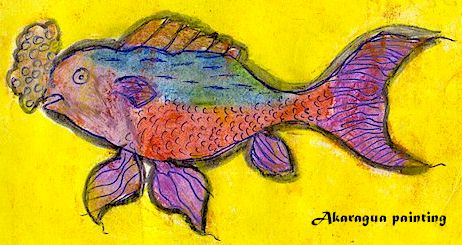 sides.
(Canyon, for those brave enough to follow it to the end, leads to Yanacocha.)
The fishing wasn’t great -- we only caught eight small piranha altogether
-- but the ride was beautiful. Along the way, we saw squirrel monkeys and
lots of birds and heard howler monkeys roaring in the distance like an oncoming
storm of thunder and wind. We canoed back to town as the setting sun sent
subtle shades of pink and yellow reflecting off the tranquil lake. As we neared
the dock, the soft light gave way to an increasing number of stars in the
darkening sky that stretched over the lake, rimmed by the silhouettes of a
billowing canopy. Back at the home of my friends, we ate fried piranha, turtle
eggs and cassava and recounted stories of past adventures in the lake and
myths of the frightening creatures, real and unreal, that are known and believed
to inhabit it: piranha, caiman, anacondas and the lake ‘monster,’
atacapi -- a giant squid-like creature that no one has ever really seen, but
supposedly has many legs and many heads and occasionally grabs a hold of canoes
at night. So, Limoncocha Lake has its very own 'Champy' or Lochness Monster,
or so they say.
sides.
(Canyon, for those brave enough to follow it to the end, leads to Yanacocha.)
The fishing wasn’t great -- we only caught eight small piranha altogether
-- but the ride was beautiful. Along the way, we saw squirrel monkeys and
lots of birds and heard howler monkeys roaring in the distance like an oncoming
storm of thunder and wind. We canoed back to town as the setting sun sent
subtle shades of pink and yellow reflecting off the tranquil lake. As we neared
the dock, the soft light gave way to an increasing number of stars in the
darkening sky that stretched over the lake, rimmed by the silhouettes of a
billowing canopy. Back at the home of my friends, we ate fried piranha, turtle
eggs and cassava and recounted stories of past adventures in the lake and
myths of the frightening creatures, real and unreal, that are known and believed
to inhabit it: piranha, caiman, anacondas and the lake ‘monster,’
atacapi -- a giant squid-like creature that no one has ever really seen, but
supposedly has many legs and many heads and occasionally grabs a hold of canoes
at night. So, Limoncocha Lake has its very own 'Champy' or Lochness Monster,
or so they say.
MERMAIDS
SEEKING HUSBANDS
Speaking of creatures of myth, according to my students at least, I once had
a mermaid swimming around my canoe. I was piranha fishing late one afternoon
on Limoncocha Lake and just as it was getting dark, I heard a giant splash
about ten yards away from my canoe. Two seconds later, a fish jumped about
two and half feet out of the water right next to where I was seated in the
boat. It came right up to my eye level. Of course, I was startled and high-tailed
it back to my house. The next day, my students claimed that there are mermaids
in the lake and they send fish to check and see if the rowers of canoes are
worthy of marriage. According to my students, the splash was a mermaid and
the fish was her scout. What do you think? My theory isn't quite so exciting.
I think the splash was a caiman and the fish jumped out of the water in an
attempt to escape from being eaten.
MISSING
FINGER DEPARTMENT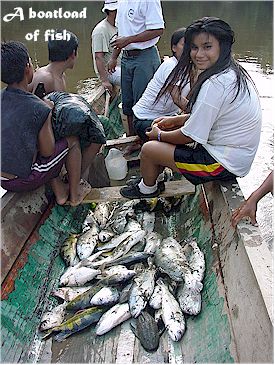
As I mentioned in my last report, piranha fishing can end with a fine dinner
-- or a missing hunk of flesh. I once lost a piece of the ring finger on my
left hand, courtesy of an ornery red-bellied piranha. It happened during an
overnight adventure I took deep into the forest with two of my high school
students several years ago. After crossing Limoncocha Lake, canoeing down
Canyon and hiking through the forest for an hour, we came to Rio Blanco (White
River), where we decided to camp for the night. (Back then Rio Blanco passed
through untouched forest: now a road crosses it.) We weren't carrying any
food with us, so I went fishing in the river and my two students went hunting
for tinamous, game birds that live on the forest floor. Luckily, I caught
two large piranha and a long green fish called a wanchinche. I managed not
to get bitten as I removed the piranha from the hook, carefully avoiding their
razor-sharp teeth as they snapped their powerful jaws over and over as if
angry they had been caught. But after making a fire as the sun set, I went
to pick up the wanchinche to clean it and, though I thought the fish were
dead by then, the piranha next to it ate its last meal – a chunk of
my finger! As I pulled my hand up in surprise and let out a sudden 'Yeowch!,'
the piranha went flipping through the air. I looked at my finger and saw a
neat round hole about a half inch in diameter and about a third of an inch
deep. My student asked, 'Es bastante?' ('Is the wound really bad?' and I replied,
'No, pero es suficiente!' (No, but it's bad enough!)
It didn't really hurt at first, maybe due to the shock. I let it bleed for
a while to help clean it, then washed it and put pressure on it till the bleeding
stopped. Then, I tore off part of my T-shirt and wrapped up my wound. One
of my students, meanwhile, picked up the piranha and looked in its mouth with
the flashlight. Sure, enough, there was the hunk of my finger. We ate the
piranha, of course, but threw the piece of finger away. The next morning,
my students looked for a certain plant which has a milky liquid that helps
cure cuts. Luckily, the cut didn't get infection, but it still took over a
month to heal completely and I still have a scar to help me remember to be
careful when I fish for piranha.
A SHOCKING
FISH TALE
Piranhas aren't the only dangerous things one can find on their hook when
fishing around Limoncocha. Two years ago I went on a fishing trip with a bunch
of teachers and students from the Amazon River Elementary School. Besides
several large piranhas and many smaller fish, one of the girls caught a 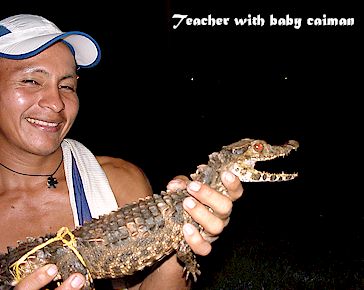 shockingly
dangerous fish. I was standing next to her in the boat when she hooked it.
She was having a hard time pulling it up out of the water because it was so
heavy, so I helped her. As soon as we pulled it to the surface of the water,
one of the other teachers in the boat hollered out, 'Don't pull it in the
boat!' Neither the girl nor I recognized what it was, but the teacher knew:
it was an electric eel!
shockingly
dangerous fish. I was standing next to her in the boat when she hooked it.
She was having a hard time pulling it up out of the water because it was so
heavy, so I helped her. As soon as we pulled it to the surface of the water,
one of the other teachers in the boat hollered out, 'Don't pull it in the
boat!' Neither the girl nor I recognized what it was, but the teacher knew:
it was an electric eel!
THE OWNER
OF BLACK LAKE
Now if you think those are interesting stories, wait to you here this one:
Last year, I took a canoe trip with the fifth grade teacher and about fifteen
students to make a video about living things in the lake. By the time we reached
the other side of the lake, however, the sky started getting dark with heavy
rain clouds. We took a detour down the Canyon, a river section that connects
Limoncocha Lake with an infamous lake called Yanacocha or Black Lake, and
sought shelter at the home of a shaman, Silverio, who lives along the river.
Black Lake, by the way, is reputed to be the home of lots of anacondas, boas,
caiman and jaguars, all of which are believed to have supernatural powers.
Even the lake itself is said to have power and supposedly gets angry when
people approach it. Silverio is said to be the owner of Black Lake and when
we visited his home he told us a story that went something like this:
'I am the owner of Black Lake. One day I was canoeing down the river towards
Black Lake. When I got close to the lake, the plants thickened in the water
and would not let me past. The lake was angry. All of a sudden, I lost my
sight. My eyes were wide open, but I couldn't see a thing. I washed my eyes
out with water; I waved tobacco leaves in front them. But, I still couldn't
see. Finally, after about a half an hour, my sight returned and I looked around
and realized that the swamp surrounding the river had closed in on me: I was
completely surrounded by a wall of swamp plants. Suddenly the animals began
to make more and more noise. There were lots of huge anacondas, but more than
anything there were an uncountable number of caiman, some of them four, five,
up to ten meters long. All of a sudden the whole swamp began to sway back
and forth. It felt like an earthquake. Then, a giant black anaconda, bigger
around than my canoe, started swimming right towards me. I noticed a small
opening in the wall of plants and rowed towards it as quickly as I could.
The snake lunged out of the water right towards me, but I managed to duck
out of the way just as the canoe squeezed through the opening.'
It was quite a story. We were all impressed. Do you think it's true? I think
some of the facts might have been stretched just a little myself, but that's
what you're suppose to do when you tell fish stories, right?
MYSTERIOUS
LAKE
Here are some more excerpts from previous years' E-mail Reports with stories
about Yanacocha -- aka Black Lake -- aka Mysterious Lake. Enjoy -- but watch
out for the anacondas!
[The sections
below were taken from a report written in 2000]
Limoncocha (Lemon Lake) and Yanacocha (Black Lake) are sister lakes. They
are connected by a river that flows downstream from Limoncocha. Limoncocha
is very well known since people live around it and fish in it every day; but
Yanacocha, even though it's so close by, remains a mystery. Nobody goes there
due to the old stories people tell about it and the fear they have towards
it. People say the river leads to a tree, then flows underground the rest
of the way to Yanacocha. They say that, long ago, many dangerous wild animals,
including boas, anacondas and jaguars with supernatural powers, lived in and
around Limoncocha; but when more and more people settled near the lake and
began to fish in it and hunt around it, the animals went deeper into the forest
to Yanacocha.
Animals that people hunted also escaped to the refuge of Yanacocha. When
hunters followed them, according to the stories, strange things happened.
Sometimes the hunters would get caught in the hypnotic trance of the boa and
keep circling back to a spot where the boa was hidden in the forest, eventually
getting disoriented and lost, never to return. Jaguars might also threaten
the invader - or the lake itself, with its own supernatural power, might suddenly
rise around the hunter, making him susceptible to the anaconda which could
create a whirlpool that would pull him under forever. If a person went near
the lake, another belief went, even on a sunny day,the lake would get angry
and clouds would suddenly appear, bringing thunder and lightening.
FIRST ATTEMPT
When I first
heard these stories, back when I lived in Limoncocha for one year in 1994
and '95, I was fascinated. While I respected the people's beliefs, I was very
curious to find out more and, possibly, to visit the lake and see some of
its wonders. But, I couldn't get anyone to take me. People told me that they
wouldn't be offended if I went to Yanacocha, but that Yanacocha might be offended,
which might be very dangerous, and they, therefore, couldn't be responsible
for anything that happened to me.
Well, if I couldn't get to the lake, at least I could try to get somewhere
close to it, I thought. There was an archeological site, a place where some
families use to live many years ago, on the land behind Yanacocha. Two high
school students of mine, German and Luis, agreed to take me there, as long
as we took a route that went well away from the feared lake. We planned a
three day venture. On day one, we canoed across Limoncocha and down the river
that goes toward Yanacocha until we came to a section that was covered with
water lilies and other plants. Since we could canoe no further, we parked
the canoe and began to hike in a right angle direction away from the river,
to avoid Yanacocha. Later in the day, we reached a smaller river, which German
and Luis knew as a barrier to the territory around Yanacocha. If we crossed
the river and hiked on the other side, we would be assured of skirting Yanacocha
on our way to the archeological site.
FINGER FOOD FOR FISH
But, it was getting late and we decided to camp by the river for the night. We were not carrying any food with us, so German and Luis went hunting and I went fishing. I caught two large piranha and a long, skinny green and white fish called a wanchinche, just enough for all of us. At dusk, I brought the fish back to the place where we were camping and, as darkness settled in, built a fire. Meanwhile, German and Luis returned with a plump tinamou. I congratulated them and went to show them my fish. I was just getting ready to clean them anyway. I reached for the wanchinche between the two piranha and--SNAP!--one of the piranha bit the side of my ring finger on my left hand. "Yeeowww!" I instinctively raised my hand and the piranha went flying up in the air. I looked at my finger and their was a big round hole in the side of it. German picked up the piranha, looked in its mouth with a flashlight and there was the chunk of my finger! After some self-first aid, I cleaned and cooked the fish while German and Luis prepared the tinamou. We ate the piranha, but we didn't eat my finger!
IN THE
BOA'S COILS
The next day, we crossed the river and hiked for several hour s, German and
Luis using the sun as a compass. At midday, though, off in the distance to
our right, we heard thunder. 'Yanacocha,' observed German pointing in the
direction of the lake, over which we could see the clouds forming. A half
an hour later, the clouds had spread to where we were hiking and it began
to sprinkle, unsettling German and Luis a little, since they could no longer
use the sun as a guide and because of a traditional belief that says evil
spirits come out in the forest during heavy rain. As we descended a quick
dip in the trail, I noticed a beautiful red flower I had never seen before
off to my left. I went over to it to take a closer look, then moved on. About
an hour later, in steadier but still light rain, I saw what I thought was
another of those beautiful red flowers off to my left--and 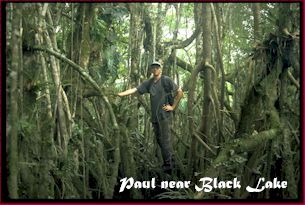 then
the trail dipped. I said to German and Luis, 'Haven't we been here before?'
They said we had. We tried to find our way again, but somehow looped back
to the same spot twenty minutes later. Then we looped intentionally, looking
for a sign of the old and rarely used trail, and, not finding it, ended up
back near the flower one more time. We were lost deep in the forest! Well,
we the knew the direction and the landmarks from which we came, so we turned
around and walked back to the river where we camped the night before.
then
the trail dipped. I said to German and Luis, 'Haven't we been here before?'
They said we had. We tried to find our way again, but somehow looped back
to the same spot twenty minutes later. Then we looped intentionally, looking
for a sign of the old and rarely used trail, and, not finding it, ended up
back near the flower one more time. We were lost deep in the forest! Well,
we the knew the direction and the landmarks from which we came, so we turned
around and walked back to the river where we camped the night before.
That night, camping at the river, German and Luis asked me how I was feeling when we were at the spot near the flower. I told them I was feeling kind of tired and light headed since we had been hiking such a long distance in the heat and we hadn't eaten. They told me they were dizzy and felt completely disoriented and explained that they believed a boa had made us lose our way and, through its power of attraction, made us loop back to that spot, where it was hidden from our view. Most likely, they said, given the thunder we heard in the direction of the lake, Yanacocha was angry that we were hiking there and did not want us to continue and the boa simply helped the lake to stop our progress.
SECOND ATTEMPT
That was as close as I would come to Yanacocha in the first year I lived there. Last year, though, when I returned to Limoncocha for a visit, I managed to get closer still. When I asked about the river connecting Limoncocha and Yanacocha, German explained that it had slowly been opening up over the years. In other words, the plants that grew on top of the water and prevented canoes from passing, for some unknown reason, were slowly disappearing, making more of the river navigable. Still, German was not interested in canoeing further downriver and recommended that I not do so. But, I was curious and, with a friend, ventured on well past the spot where we had to park the canoe four years before. As we canoed, the river got narrower and narrower, and further down, the weeds returned, but just in patches. As we navigated our way through the patches, we noticed that the birdlife was thicker here. We saw cocoi herons, anhingas, Amazon kingfishers, limpkins, hoatzins and one huge wood stork among many others. But soon, the plants on top of the water thickened again and we had to turn back.
It was a beautiful and peaceful place, with no signs of threatening animals--or spirits; but then again, we still hadn't reached Yanacocha.
[The next sections were taken from a 2001 report.]
WHITE
RIVER AND BLACK LAKE
Over the past five years, some people in Limoncocha have lost some of their
fear towards Yanacocha.They realize that Yanacocha might be an interesting
place for tourists to visit and that tourism can be a good way for people
in the village to earn money. So, the community built a cabin and a lookout
tower on a hill next to the very river where I lost that chunk of my finger
to the piranha a few years back. They also made some canoes for tourists to
navigate the river and, most impressively, two hiking trails in the area,
one that, supposedly, goes from the river straight to the shores of Yanacocha!
When I asked about staying at the cabin, canoeing on the river and hiking
to Yanacocha, a community leader told me I was welcome to do so. He told me
I needed to talk with the man who takes care of the cabin since only he knew
how to find the trailheads. So, I organized with my former student and guide,
German, to go there. When we reached the cabin, there were some men working,
cleaning the grounds, but the man who knew about the trails was not there.
We decided to go looking for ourselves, since we had a rough idea of where
the trails were and we knew where Yanacocha was in relation to the river.
German and I canoed for several hours down the river, stopping every so often
to fish and to look at birds and, all the while, keeping a lookout for the
trails. The area surrounding the river is very beautiful. Much of it is swamp
and there are some wide open spaces surrounded by gigantic trees propped up
by incredible mazes of mangled roots. Finding your way through the roots and
sometimes climbing up and around them is one of the most amazing Amazon adventures
you could experience.
We caught lots of fish and saw lots of birds. At one point we canoed right underneath a branch with a baby hoatzin perched on it. The parents noisily flew off as we approached, but the baby couldn't fly and just clung to the branch. Baby hoatzins are famous for a Houdini act they sometimes pull when in danger. If a predator approaches, they flop out of the tree and plop into the water below. When the predator moves on, they resurface, swim over to the shore and climb back up into the tree, using hooks they have on their shoulders to help them climb. I thought I might get to witness the stunt, but the young bird stayed put, even as I took a few mug shots with my camera. We also heard the jungle-chorus of the horned screamer, a giant swamp bird, whooping, gurgling and, well, screaming, throughout the trip. At one point, we even saw one of the huge horned honkers as it clumsily took to the air only a stone's throw away from our canoe, off in the swamp. But, we never found the trails.
FOILED AGAIN
Way down river, across from Yanacocha, rain clouds gathered and we heard thunder
in the distance. Then we heard the hum of the distant rain, washing louder
and louder as it approached. We parked the canoe and took shelter under the
roots, waiting for the rain, which now sounded like a train, a rolling, roaring
waterfall on a track that seemed to lead right to our door, to wash over and
past us. After, we bailed the canoe and headed further downstream, still looking
for the trails. We must be close! But the rain came again, this time preceded
by loud, strange sounding thunder, a muffled tear that sounded as if it came
from the ground instead of the sky, like the growl of an imprisoned jaguar.
The thunder was rattling off the swamp, I thought, which made it sound different
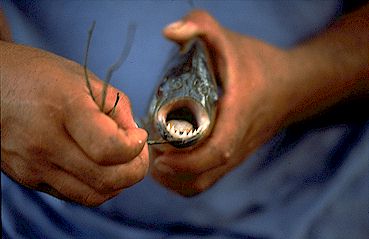 from
any thunder I had ever heard before. German had another explanation. He told
me that some kinds of thunder do come from underground and are caused by the
spirits that live in the earth. Or, he explained, it could have been the small
man who, people believe, lives around the swamp and sometimes beats a stick
on the trunks of hollow trees when it rains to make the odd thunder sound.
from
any thunder I had ever heard before. German had another explanation. He told
me that some kinds of thunder do come from underground and are caused by the
spirits that live in the earth. Or, he explained, it could have been the small
man who, people believe, lives around the swamp and sometimes beats a stick
on the trunks of hollow trees when it rains to make the odd thunder sound.
This time we stayed under the roots longer. The rain finally slowed, but did
not entirely pass, and we decided to canoe back upstream to the cabin. When
we arrived, late in the afternoon, we met a disheartening surprise. For some
odd reason, though we were given permission to stay, the cabin was locked
and our bags were outside on the front steps. So, we walked ALL the way back
to Limoncocha, lugging our camping gear over our shoulders, walking past jaguar
trails, listening to the haunting whistles of tropical screech owls and their
hooting kin, in the DARK!
YET ANOTHER ATTEMPT
Since we
couldn't reach Yanacocha by trail, we thought we'd try another approach. In
years past, German did not want to try to canoe far down the river that connects
Limoncocha and Yanacocha.But, in the past year, German has been working at
a nearby tourist lodge and some of his ideas about the forest have changed.
This year, he readily agreed to canoe as far down the river as we could, and
even to canoe into Yanacocha, if possible.
Even since last year, the river has opened up more; that is, the plants that
had covered the river and made it impossible to navigate, have slowly disappeared.
Earlier in the week, I had traveled far down the river with a canoe full of
teachers and sixth grade students. We went on a fishing trip that yielded
a wide variety of fish, including lots of sunfish, chuti and acaragua, a whole
bunch of piranha – some nearly the size of a dinner plate -- and even
one electric eel! As we fished, we drifted further and further down the river,
until we came to a place where plants again covered the water and blocked
the way. We fished there till dark clouds began to gather further downstream
and thunder rumbled. One of the teachers commented, pointing downriver, 'Yanacocha
is angry,' and informed me that the lake was only a short distance away. I
was surprised to find that all of the teachers and the students were not as
scared to be that close to the lake as they certainly would have been five
years before when I first lived in Limoncocha; but mostly I was curious about
what lay beyond that spot as I observed that a smaller canoe might be able
to pass through some openings in the plant cover.
HOWLERS AND HUMMINGBIRDS
So, the day after walking for hours in the night, German and I headed towards
Yanacocha in a smaller canoe. Sure enough, there were thin lanes of open water
through which we could maneuver the canoe. In other spots where there were
no lanes, we could power our way through the weeds, rowing as hard as we could
or 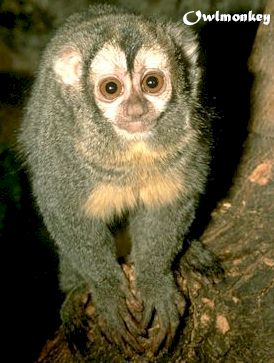 standing
and rocking the canoe to make it inch forward until we made it to the next
patch of clear water. Little by little, with lots of effort, we were getting
closer and closer to Yanacocha. The scenery was beautiful and the wildlife
abundant. We saw troupes of squirrel monkeys and red howlers. We saw schools
of large fish in the water and an array of different bird species, including
a rare tiger heron and more anhingas (birds that 'fly' underwater, spear fish
with their bills and then stick their long snake-like necks up out of the
water to swallow their catch) in a half an tour than one might see all day
around the lake and further upstream on the river. And just when we thought
the last patch of plants we were busting through would open up on Yanacocha
and reveal its long-hidden wonders, we met a sudden dead end -- a patch of
tall, thick grass that was floating on the water and blocking our way forward.
I asked German if we might park the canoe and walk the rest of the way to
the lake, but he pointed out that swamp on both sides of the river would prevent
us from doing so. We had no choice but to turn back, once again denied! But,
at that last patch of tall, thick grass, I saw a sudden flash and flicker
of light -- a hummingbird. German explained that the people believe they are
messengers of welcome. Since they supposedly only drink nectar and harm no
living thing, they are thought to be pure, and their presence a sign of good
luck.
standing
and rocking the canoe to make it inch forward until we made it to the next
patch of clear water. Little by little, with lots of effort, we were getting
closer and closer to Yanacocha. The scenery was beautiful and the wildlife
abundant. We saw troupes of squirrel monkeys and red howlers. We saw schools
of large fish in the water and an array of different bird species, including
a rare tiger heron and more anhingas (birds that 'fly' underwater, spear fish
with their bills and then stick their long snake-like necks up out of the
water to swallow their catch) in a half an tour than one might see all day
around the lake and further upstream on the river. And just when we thought
the last patch of plants we were busting through would open up on Yanacocha
and reveal its long-hidden wonders, we met a sudden dead end -- a patch of
tall, thick grass that was floating on the water and blocking our way forward.
I asked German if we might park the canoe and walk the rest of the way to
the lake, but he pointed out that swamp on both sides of the river would prevent
us from doing so. We had no choice but to turn back, once again denied! But,
at that last patch of tall, thick grass, I saw a sudden flash and flicker
of light -- a hummingbird. German explained that the people believe they are
messengers of welcome. Since they supposedly only drink nectar and harm no
living thing, they are thought to be pure, and their presence a sign of good
luck.
So, Yanacocha remains a mystery to me -- but I had lots of fun trying toget there -- and I hope you enjoyed the adventure, too. Maybe next time, if the hummingbird is any indication, I'll have better luck.'
LATEST ATTEMPT
Limoncocha Tour (2003)
Today, Lilia,
Johanna and I went for a motorized canoe trip with seven students and a park
ranger from the Limoncocha Biological Reserve. We crossed Limoncocha Lake
and canoed down the river that connects Limoncocha to Yanacocha, a.k.a. Black
Lake. We never actually reached Yanacocha because just before Yanacocha begins,
there is a thick layer of plants blocking the passage. We did a little fishing
along the way, catching a piranha, a little white fish with a black spot near
the gill that people here call sardina, and a vieja (like a sunfish); and
one of the students left a net in the water to check later in the day. But
our main purpose for the trip was to make a video about birds around the lake
for the Martin Luther King Magnet School in 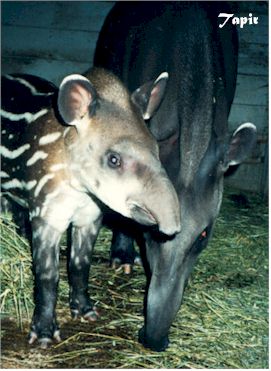 Schenectady,
NY, where the fifth graders are studying birds, including how some spend the
summer in North America and the winter in the Amazon Rain Forest in South
America.
Schenectady,
NY, where the fifth graders are studying birds, including how some spend the
summer in North America and the winter in the Amazon Rain Forest in South
America.
We saw and videotaped lots of birds including doves, hoatzins, donicobiuses,
jacanas, anis, striated herons, cocoi herons, caciques, kiskadees, flycatchers,
jacaris, vultures and kingfishers. We also so a toucan, a big flock of parrots,
several purple gallinules and an osprey, but weren't quick enough to videotape
them. So birds were the stars of the show, but we also some a troupe of squirrel
monkeys and heard a bunch of howler monkeys roaring in the distance when we
were down by Yanacocha. On the way back, we got drenched by heavy rain; but,
on the whole, we had lots of fun and came out with a nice video -- and fish
for supper.
----------------------------------------------
Guess
Who
The answers to the last report's poems, by the way, are: 1. the yellow-spotted
Amazon River turtle and, not coincidentally, 2. the tarantula.
Here's a poem for this report:
Mystery Animal #5: Tree Beeper
Beep-beep-beep
I'm beeping in my tree - beep-beep
Leaping on my leaves - leap-leap
Keeping my leaps discreet - sneak-sneak
Steering
of clear of beaks - tweet-tweet
Veering free of teeth - seize-seize
I'm sneaking out to feed - seek-seek
Peeking out to see - peep-peep
My buzzing meals of meat - treat-treat
Beetles, flies and bees - sweet-sweet
I'll greet them with a sweep - sweep-sweep
And real them in for keeps - keep-keep
While beeping to the beat
Beep-beep-beep
Who might I be?
==========================================================================
Question
and Answer
Here are more answers to your questions, answered by 1st through 8th grade
students at the Victor Davalos School in Playas de Cuyabeno and,
in a few cases (noted with an L) by children in Limoncocha. To match this
report's main theme, we stuck with bug and animal questions:
What are
some of the animals in your neighborhood? Have you ever seen a tiger up close?
We have river dolphins, tapir, peccary, capybara, jaguars,
ocelots, macaws, agoutis, monkeys and sloths, just to name a few, plus lots
of birds, frogs, insects and fish.
What is the most dangerous animal in the rain forest? The
most dangerous because of their spiritual powers are jaguars, boas and anacondas.
But they do not usually bother people if people don't bother them. The animal
that can kill you quickly and is mostly likely to kill a person is a poisonous
snake. We have several different kinds that live near us. [Note from Paul:
Mosquitos are actually the main rain forest killer since they can pass on
deadly diseases. Many more people die from malaria than from snake bite, though
most people who get malaria get cured if they take the proper medecine in
time. ]
Are there poisonous animals around you? Yes, besides
the snakes, tarantulas, scorpions, rays and certain ants have poison.
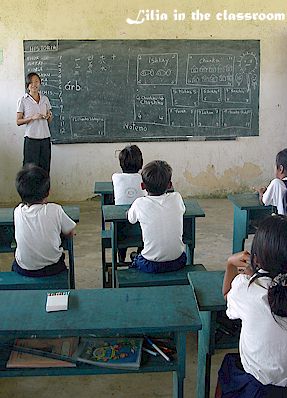
Any dangerous encounters with animals? (L) Rarely. One
boy died from snake bite about 10 years ago. Another small boy was taken by
an anaconda about twenty-five years ago (or so we are told by our parents).
Some of us have had pieces of our hand or foot bitten off by piranha while
fishing. A man in our village had his arm nearly bitten off by a caiman two
years ago, but that's the only time anyone can remember a caiman biting a
person. He went to the hospital to get his arm sewed back up and today he
can't use it like he used to. Many of us have been stung by congas (large
ants), but the pain goes away after a day.
What is the biggest animal around? Tapirs, manatees and anacondas are all
very large. After that would be the river dolphin.
Are there any animals that attack humans? (L) See above.
Usually animals don't attack. We heard a story, though, of a man who was killed
by a jaguar, far down the Napo river from here. The man was an oil company
worker and people here say that the jaguar was really a shaman who didn't
want the oil company to drill for oil in the area.
How big is the biggest bug you've ever seen? (L) Some
blue morpho butterflies are about the size of two adult hands, each hand like
one wing. Some beetles and walking sticks around our town can get about five
or six inches long.
Do you like living by the Amazon River and seeing all of the animals? We live
near the Aguarico River, but yes we like living here and seeing the animals.
Could you tell us some endangered animals in your area? Charapas (yellow spotted
river turtles), manatees, river dolphins and brown wooly monkeys.
Is it scary to live in the rain forest? No, we enjoy our life here, although
it is true that some of the stories people tell about jaguars and anacondas
and boas are scary. Most of us don't like to go in the forest at night or
after a heavy rain.
That’s
All for Now
That’s all for this report. Next time, we’ll fill you in on our
trip to Cuyabeno. Till then, learn lots!
Paul, Lilia
and Teresa
------------------------------
| E-Travel Log #1: Introduction to the Project and the Adventure Team |
| E-Travel Log #2: Quito, Banos and Flashbacks of Christmas Celebrations in Limoncocha |
| E-Travel Log #3: Banos - Where the Rain Forest Begins |
| E-Travel Log #4: Limoncocha - A Quichua Community |
| E-Travel Log #5: Limoncocha and Communities Around - Traditions and Cultures |
| E-Travel Log #6: Getting Ready to Leave for Cuyabeno |
| E-Travel Log #7: Rain Forest Animals |
| E-Travel Log #8: Rain Forest Stories and the Mysterious Black Lake |
| E-Travel Log #9: Trip to Playas de Cuyabeno |
| E-Travel Log #10: Trip to San Pablo - a Secoya Community |
